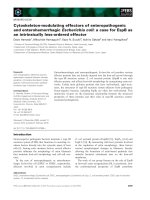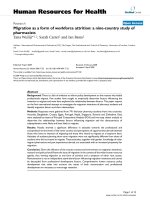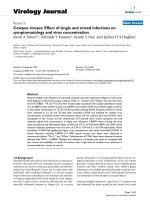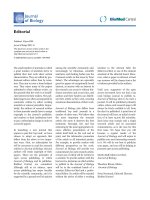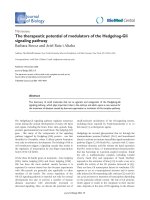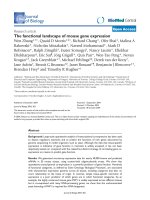Báo cáo sinh học: "Insulators as mediators of intra- and inter-chromosomal interactions: a common evolutionary theme" ppsx
Bạn đang xem bản rút gọn của tài liệu. Xem và tải ngay bản đầy đủ của tài liệu tại đây (128.24 KB, 4 trang )
Ong and Corces: Journal of Biology 2009, 8:73
Abstract
Insulator elements mediate intra- and inter-chromosomal inter actions.
The insulator protein CCCTC-binding factor (CTCF) is important
for insulator function in several animals but a report in BMC
Molecular Biology shows that Caenorhabditis elegans, yeast
and plants lack CTCF. Alternative proteins may have a similar
function in these organisms.
Eukaryotic genomes have developed a variety of strategies
for efficiently orchestrating the complex patterns of gene
expression required for proper cellular differentiation. Com-
parative genome analyses suggest that developmental
evolution is largely driven by the increase in the complexity
of these expression patterns [1]. Consistent with this hypo-
thesis, recent studies indicate that transcription factor-
coding genes tend to be under greater positive evolutionary
selection compared with other genes [2]. To establish and
maintain cell-specific patterns of gene expression, regions of
the genome are kept in a silenced state while imme diately
adjacent regions are transcriptionally active because of the
presence of promiscuous enhancer elements that can act
over large distances. Insulators were originally des cribed as
DNA regulatory elements that ensure the progress of an
accurate transcriptional program by keeping in check
communication between enhancers and promo ters and
creating boundaries that prevent inappropriate interactions
between adjacent chromatin domains. Accu mu lating
evidence suggests that these properties of insulators arise
from their ability to mediate intra- and inter-chromosomal
interactions, which result in the formation of chromatin
loops through clustering of multiple insulator sites [3].
Depending on the complexity of the genome, the capability
to mediate long-range interactions with other protein
complexes may allow insulator proteins to carry out a
variety of functions in the nucleus [4].
CCCTC-binding factor (CTCF) is the only known insulator
protein necessary for establishing patterns of nuclear
architecture and transcriptional control in vertebrates [5].
This protein is also found in invertebrates such as
Anopheles gambiae, Aedes aegypti and Drosophila
melanogaster [6]. A recent study by Heger et al. in BMC
Molecular Biology [7] has shown that the gene encoding
CTCF is not present in the genomes of several model
organisms, including Saccharomyces cerevisiae, Schizo-
saccharo myces pombe, Arabidopsis thaliana and Caeno-
rhab ditis elegans. Because of the widespread presence of
insulators and the essential role of CTCF in a wide variety
of eukaryotic organisms, this absence of the gene in other
organisms raises the possibility that other regulatory
mechanisms might have evolved to replace the function of
this protein. Here, we provide a brief overview of how
insulator proteins work in Drosophila and vertebrates, as
well as how plants and fungi may have adapted different
proteins to accomplish insulator function. We also discuss
how insulator proteins such as CTCF may have evolved new
functions to handle more complex genomes in animals.
Examples of insulator function
The mechanisms of insulator function are best understood
from analyses of the gypsy element of Drosophila. Gypsy
insulator sites are bound by the Suppressor of Hairy-wing
protein (Su(Hw)), in a sequence-specific manner. This
protein in turn recruits other factors, including centro-
somal protein 190 kDa (CP190), Modifier of mdg4
(Mod(mdg4)2.2), topoisomerase I-interacting RS protein
(dTopors) and RNA, to form clusters of ‘insulator bodies’
(consisting of these proteins and DNA) with multiple
gypsy sites [8] (Figure 1a). Recently, other Drosophila
insulator proteins, dCTCF and Boundary element asso cia-
ted factor (BEAF), have also been shown to recruit CP190
to specific DNA sites [9], suggesting that loop formation
through long-range protein interactions mediated by
CP190 might be the underlying mechanism for insulator
function in Drosophila.
The concept of intra- and inter-chromosomal interaction
mediated by insulator proteins in Drosophila seems to be
applicable to the CTCF insulator in vertebrates, despite the
involvement of a different set of protein complexes. The
mechanism of CTCF function in vertebrates is best illus-
trated by the mouse imprinted Igf2-H19 locus [3], where
four CTCF-binding sites are located at the imprinted
Minireview
Insulators as mediators of intra- and inter-chromosomal
interactions: a common evolutionary theme
Chin-Tong Ong and Victor G Corces
Address: Department of Biology, Emory University, 1510 Clifton Road NE, Atlanta, GA 30322, USA.
Correspondence: Victor G Corces. Email:
73.2
Ong and Corces: Journal of Biology 2009, 8:73
control region (ICR) that lies between the Igf2 gene and its
downstream enhancers (Figure 1b). CTCF binds to these
sites on the maternally inherited allele but not on the
methylated paternal copy. Chromatin conformation
capture (3C) experiments revealed distinct long-range
chromo somal interactions that are specific to the parent of
origin (Figure 1b). On the maternal allele, a CTCF-depen-
dent loop formed by contacts between DNA methylated
region 1 (DMR1) and the ICR allows downstream enhancers
to turn on the H19 gene. However, on the paternal allele,
contacts between DMR2 and ICR allow downstream
enhancers to activate the Igf2 gene. Given that CP190
protein has been shown to interact with CTCF in Drosophila,
what proteins could then mediate CTCF-depen dent looping
Figure 1
Loop formation through intra- and inter-chromosomal interactions is a common strategy for genome organization and insulation in different
organisms. (a) In Drosophila, the Su(Hw) protein binds to specific DNA elements and recruits the CP190 protein and Mod(mdg4)2.2 proteins.
Interaction among these proteins results in the formation of chromatin loops. Mod(mdg4)2.2 attaches the chromatin to the nuclear periphery
through its interaction with topoisomerase I-interacting RS protein (dTopors). (b) Monoallelic expression at the Igf2-H19 locus is regulated by
binding of CTCF to the imprinted control region (ICR). On the maternal allele, CTCF mediates interactions between ICR and DNA methylated
region 1 (DMR1) that also involve joining of the DNA strands by cohesin, insulating Igf2 from the influence of downstream enhancers.
Methylated ICR sequences prevent CTCF from binding to the ICR on the paternal allele, allowing downstream enhancers to switch on Igf2
transcription. (c) In S. pombe, TFIIIC binds to RNA polymerase (Pol) III at tRNA genes and acts as a barrier against the spreading of
heterochromatin. It is also hypothesized to organize the chromatin into distinct loops by clustering various chromosome-organizing clamp
(COC) loci to the nuclear periphery. (d) In A. thaliana, binding of the ASYMMETRIC LEAVES1 (AS1)-AS2 complex at two specific DNA sites
flanking the enhancer is required to silence the expression of the BP gene. Recruitment of the histone chaperone HIRA is necessary for this
process, and it probably acts by facilitating looping of the enhancer element.
Nuclear lamin
Nuclear lamin
dTopors
CP190
Su(Hw)
Mod(mdg4)2.2
DMR1
DMR2
Enhancers
ICR
Igf2
H19
H19
Igf2
DMR1
DMR2
ICR
Cohesin CTCF other factors
(a) Drosophila (b) Mouse
(c) Yeast (d) A. thaliana
TFIIIC Pol III
COC loci tRNA gene
BP
Enhancer
X
AS1 AS2 HIRA
73.3
Ong and Corces: Journal of Biology 2009, 8:73
of chromatin in vertebrates? Recent data indicate that
cohesin might be required for CTCF insulator function [10].
Cohesin complexes mediate co hesion between sister
chromatids by connecting two distinct DNA molecules
physically. It is therefore plausible that cohesin can create or
stabilize DNA loops during interphase by physically
connecting different CTCF-binding sites on the same or
different DNA molecules, in a manner similar to CP190 and
Mod(mdg4) proteins in Drosophila.
If CTCF or functionally similar proteins have a role in
establishing patterns of nuclear organization by mediating
intra- and inter-chromosomal interactions, how do
organisms that lack CTCF homologs accomplish the same
goal? In S. pombe and S. cerevisiae, the transcription
factor TFIIIC seems to have this role. In fission yeast,
binding of TFIIIC to B-box sequences in the inverted
repeat boundary elements can prevent the spreading of
heterochromatin from the silenced mating-type loci to
neighboring euchromatic regions [11]. Detailed genome-
wide analyses reveal that TFIIIC associates with RNA
polymerase (Pol) III on all tRNA genes, which are mostly
found at pericentromeric heterochromatin domain boun-
daries. In addition, TFIIIC binds to many sites between
divergent promoters in the absence of Pol III and acts as a
chromosome-organizing clamp (COC) by tethering distant
loci to the nuclear periphery [11] (Figure 1c). Similarly,
TFIIIC recruited to tRNA genes in budding yeast can act as
both an enhancer-blocking insulator and a hetero chro-
matin barrier by preventing ectopic spreading of Sir
protein-mediated silencing [12]. These results uncover a
general mechanism of genome organization involving the
conserved TFIIIC complex in yeast.
Studies of the process by which KNOTTED1-like homeobox
(KNOX) genes are silenced during organogenesis suggest
that A. thaliana may also use chromatin looping as a way
of regulating gene expression [13]. Stable KNOX gene
silencing requires the DNA-binding proteins ASYMMETRIC
LEAVES1 (AS1) and AS2 and the chromatin-remodeling
factor HIRA. AS1 and AS2 form a repressor complex that
binds directly to two DNA motif sites that flank the
enhancer element of the KNOX genes BREVIPEDICELLUS
(BP) and KNOTTED-like Arabidopsis (KNAT2) . Inter-
action between AS1-AS2 complexes at these two sites is
required to repress BP expression. These results suggest
that AS1-AS2 complexes interact to create a loop in the
KNOX promoter and, through recruitment of HIRA, to
form a repressive chromatin state that blocks enhancer
activity during organogenesis (Figure 1d). This regulatory
mechanism, which may be conserved among plants with
compound leaves, is conceptually similar to the action of
an insulator in Drosophila and vertebrates.
Recent phylogenetic studies using the zinc-finger protein
sets from 35 completely sequenced nematodes [7] has
discovered the presence of CTCF-like genes in only three
basal nematodes and not in other derived nematodes such
as C. elegans. This suggests that CTCF might have been
lost during nematode evolution, probably as a result of a
switch from gene regulatory mechanisms involving
distantly acting elements and chromatin insulation to
polycistronic transcriptional units [7]. However, the
presence of higher-order genome organization in yeast
suggests the possibility that other protein complexes may
have evolved to replace CTCF functions in C. elegans.
Common themes
The underlying theme governing insulator function seems
to be the establishment of intra- and inter-chromosomal
interactions that bring different sequences in close
proximity within the nucleus to accomplish a variety of
outcomes [4]. Different eukaryotes may have evolved
unique machineries to achieve this. It is also clear that
insulator proteins such as CTCF may have acquired
additional functions with increased complexity of the
genome (reviewed in [4]). In yeast (S. cerevisiae), which
has a haploid genome size of 13 megabases, the primary
insulator function of TFIIIC seems to be the demarcation
of chromatin into distinct domains for blockage of
heterochromatin silencing. In A. thaliana, in which genes
are only infrequently interrupted by repetitive elements
outside the centromeric regions, AS1-AS2 complexes may
mainly act to regulate enhancer-promoter interactions.
Long-range interactions mediated by insulator proteins
have wider functional implications for Drosophila and
mammals. In Drosophila, different insulators have diverse
DNA occupancy patterns with respect to gene features,
suggesting that the various insulator functions have
diversified by using different insulator DNA-binding
proteins with a common interacting partner [9].
Interestingly, vertebrate cells, which contain a larger
genome that requires more complex forms of regulation,
seem to require CTCF to have a wider set of regulatory
roles. These include transcriptional regulation of gene
expression at the major histocompatibility complex class
II, β-globin and interferon-γ loci, V(D)J recombination at
the immunoglobulin-encoding Igh and Igk loci, mono-
allelic expression of imprinted genes and X-chromosome
inactivation [4]. The ability to have such varied roles must
rely on context-dependent interactions with a variety of
partners. Their identification remains one of the future
challenges for the field.
Acknowledgements
Work in the authors' laboratory is supported by Public Health
Service Award GM35463 from the National Institutes of Health.
References
1. Shubin N, Tabin C, Carroll S: Deep homology and the origins
of evolutionary novelty. Nature 2009, 457:818-823.
2. Vaquerizas JM, Kummerfeld SK, Teichmann SA, Luscombe
NM: A census of human transcription factors: function,
expression and evolution. Nat Rev Genet 2009, 10:252-263.
73.4
Ong and Corces: Journal of Biology 2009, 8:73
3. Wallace JA, Felsenfeld G: We gather together: insulators
and genome organization. Curr Opin Genet Dev 2007, 17:
400-407.
4. Phillips JE, Corces VG: CTCF: master weaver of the
genome. Cell 2009, 137:1194-1211.
5. Hore TA, Deakin JE, Marshall Graves JA: The evolution of
epigenetic regulators CTCF and BORIS/CTCFL in amni-
otes. PLoS Genet 2008, 4:e1000169.
6. Gray CE, Coates CJ: Cloning and characterization of cDNAs
encoding putative CTCFs inthe mosquitoes, Aedes aegypti
and Anopheles gambiae. BMC Mol Biol 2005, 6:16.
7. Heger P, Marin B, Schierenberg E: Loss of the insulator
protein CTCF during nematode evolution. BMC Mol Biol
2009, 10:84.
8. Bushey AM, Dorman ER, Corces VG: Chromatin insulators:
regulatory mechanisms and epigenetic inheritance. Mol
Cell 2008, 32:1-9.
9. Bushey AM, Ramos E, Corces VG: Three subclasses of a
Drosophila insulator show distinct and cell type-specific
genomic distributions. Genes Dev 2009, 23:1338-1350.
10. Wendt KS, Peters JM: How cohesin and CTCF cooperate in
regulating gene expression. Chromosome Res 2009, 17:
201-214.
11. Noma K, Cam HP, Maraia RJ, Grewal SI: A role for TFIIIC
transcription factor complex in genome organization. Cell
2006, 125:859-872.
12. Simms TA, Dugas SL, Gremillion JC, Ibos ME, Dandurand MN,
Toliver TT, Edwards DJ, Donze D: TFIIIC binding sites func-
tion as both heterochromatin barriers and chromatin insu-
lators in Saccharomyces cerevisiae. Eukaryot Cell 2008,
7:2078-2086.
13. Guo M, Thomas J, Collins G, Timmermans MC: Direct repres-
sion of KNOX loci by the ASYMMETRIC LEAVES1 complex
of Arabidopsis. Plant Cell 2008, 20:48-58.
Published: 27 August 2009
doi:10.1186/jbiol65
© 2009 BioMed Central Ltd
